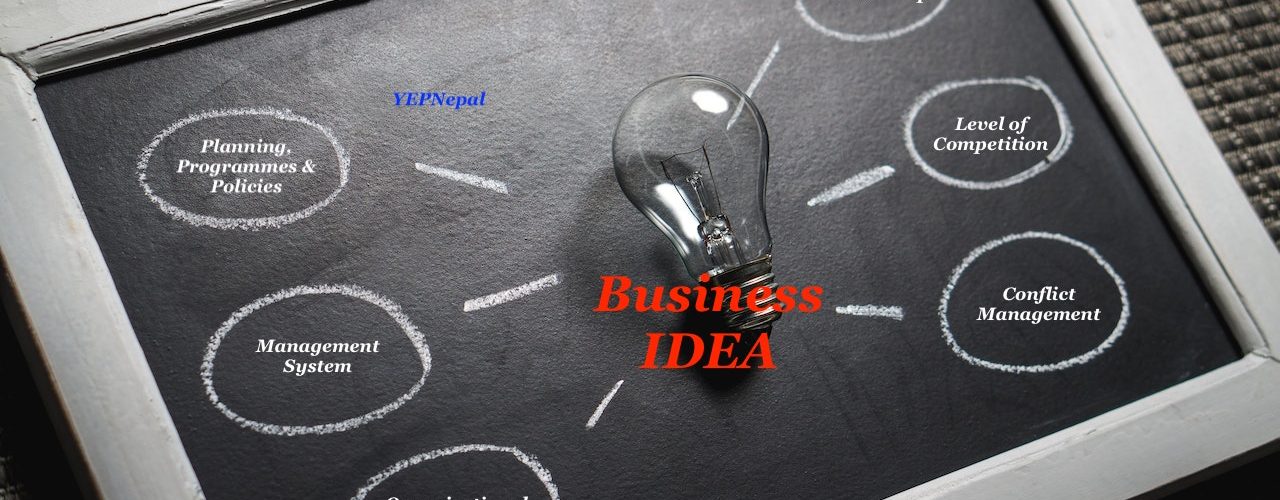Business Idea

A business idea is a conceptual plan or innovative concept that outlines a unique product, service, or approach intended to fulfill a market need or capitalize on an opportunity, aiming to generate profits and create value. According to renowned scholar Peter Drucker, “a business idea is the intersection of identifying a customer’s unmet need and devising a solution that provides superior value compared to existing alternatives“. It involves recognizing trends, understanding customer behavior, and crafting a strategy to deliver a compelling offering, thus forming the foundation for a potential business venture.
Creativity and Innovation
Creativity and innovation serve as the dynamic gateway through which business ideas transform from conceptual notions into tangible realities. Creativity involves the generation of novel concepts, solutions, and approaches, while innovation entails the practical implementation of these creative ideas to bring about meaningful change. This synergy is a catalyst for translating business ideas into viable ventures.
Creativity involves the generation of original and imaginative ideas that challenge conventional thinking. It is the ability to think beyond established boundaries, combining existing knowledge in unique ways to create fresh perspectives and opportunities. Creative individuals often question assumptions, explore diverse viewpoints, and embrace uncertainty to unlock new pathways.
According to Mumford, “Creativity involves the production of novel and useful products applicable to the people.”
According to Robert Stemberg, “Creativity involves the production of something products and services having original and worthwhile.”
Innovation, on the other hand, is the process of applying creative ideas to solve problems or meet specific needs. It’s the transformation of abstract concepts into tangible products, services, or processes that offer value to customers and the market. Innovation requires a systematic approach that includes design, development, testing, and implementation to turn visionary concepts into practical reality.
According to Leonard and Rayport, “Innovation refers to improving products, services and the existing processes that create value to the customers.”
According to Kenneth Simmonds, “Innovations are new ideas that consist of new products and services, new use of existing products, new markets for existing products or new marketing methods.”
Together, creativity and innovation form a powerful tandem that not only sparks the inception of revolutionary business ideas but also guides their journey from inception to execution. This exploration delves into the distinct essence of creativity and innovation while unraveling their intertwined roles in shaping the destiny of businesses and industries
Business Idea Generation
Basics of Creative Behaviour
The basics of creative behavior encompass fundamental traits and actions that foster innovation. These include imaginative thinking, risk-taking, self-expression, collaborative engagement, embracing challenges, open communication, and participation in research and development. Such behaviors underpin the generation of original ideas and solutions across various domains.
-
Imagination and Originality: Creativity often involves thinking beyond conventional boundaries and coming up with novel ideas. Imagination allows individuals to envision new concepts and solutions that haven’t been explored before.
-
Flexibility and Risk-Taking: Creative individuals are open to trying new approaches and taking risks. They are willing to step outside their comfort zones and experiment with unconventional methods, which can lead to innovative outcomes.
-
Self-Expression: Creative behavior enables individuals to express themselves authentically. Whether through art, writing, music, or other mediums, people can communicate their thoughts, emotions, and perspectives in unique ways.
-
Collaboration: Collaboration brings together diverse ideas and skills, fostering a fertile ground for creativity. Working with others who have different viewpoints and expertise can lead to the synthesis of innovative solutions.
-
Accepting Challenges: Creative individuals often embrace challenges as opportunities for growth. They see problems as puzzles to solve, and the process of overcoming challenges can lead to creative breakthroughs.
-
Open Communication: Effective communication is vital for sharing ideas and receiving feedback. Being able to openly express thoughts and listen to others’ opinions can lead to the refinement and improvement of creative concepts.
-
Involvement in Research and Development: Engaging in research and development activities provides a structured environment for exploring new ideas and pushing the boundaries of current knowledge. This process can lead to advancements and innovations.
These features collectively contribute to the creative process, which varies across individuals and disciplines. Creative behavior can be observed in fields like art, science, technology, business, and more, where innovative thinking drives progress and change. It’s important to note that creativity is a multifaceted trait and can manifest differently in different individuals. Additionally, not all creative individuals will exhibit all of these features all the time, but these characteristics provide a general overview of what creative behavior might entail.
Source of Business Ideas
A “source of business idea” refers to a place, concept, or channel from which entrepreneurs or individuals gather inspiration and information to develop new and innovative concepts for products, services, or ventures. These sources could include existing products, market trends, technological advancements, customer needs, or other external factors that spark creative business opportunities.
- Existing products: A business can develop new business ideas by analyzing existing products. This can be done by identifying areas where the existing products can be improved, such as by making them more affordable, durable, or user-friendly. The business can also develop new products that are complementary to existing products, or that meet the needs of a new market segment.
- Government policies: Government policies can also be a source of business ideas. Businesses can identify new opportunities by tracking government policy changes, such as changes in taxation, regulation, or trade policy. They can also partner with government agencies to develop new products or services that meet the needs of the public sector.
- Research and development: Research and development (R&D) is another important source of business ideas. By conducting R&D, businesses can develop new products or services that are innovative and meet the needs of their target markets. R&D can also be used to improve existing products or services.
- Business actors’ network: A business’s network of business actors, such as buyers, suppliers, consultants, and channel members, can also be a valuable source of business ideas. By talking to these individuals, businesses can learn about the needs and challenges of their customers, suppliers, and other stakeholders. This information can be used to identify new opportunities for business growth.
By carefully analyzing these sources, individuals can identify trends, pain points, opportunities, and areas for innovation. It’s often the intersection of these sources that can lead to truly novel and successful business ideas. Remember, creativity and a deep understanding of the market are crucial when translating these analyses into viable business concepts.
Tools and Techniques for Generating Business Ideas
Tools and techniques for generating new business ideas refer to systematic approaches used to foster creative thinking and innovation. They include methods such as brainstorming, expert opinions, and structured frameworks like SCAMPER, which encourage idea generation, exploration, and refinement for the development of fresh and viable business concepts.
Here are the tools and techniques for generating new business ideas, along with brief explanations for each point:
1. Brainstorming: Brainstorming is a creative technique where a group of individuals generates a large number of ideas spontaneously, without judgment or criticism. It encourages free thinking and idea generation by allowing participants to build upon each other’s thoughts.
2. Expert Opinion: Seeking input from experts in a specific industry or field can provide valuable insights and new perspectives. Experts can offer informed opinions and share trends, market gaps, and potential opportunities that may not be immediately obvious.
3. SCAMPER: SCAMPER is an acronym that represents different ways to approach and modify existing ideas in order to generate new ones. Each letter corresponds to a different approach:
- Substitute: Replace a component or aspect of an idea with something else.
- Combine: Merge two or more ideas, concepts, or features to create a new solution.
- Adapt: Alter or adjust an idea to fit a new context or application.
- Maximize or Minimize (Modify or Magnify): Enhance or reduce certain attributes of an idea.
- Put to Other Use (Purpose): Repurpose an idea for a different application or audience.
- Eliminate: Remove certain elements or components to simplify or refine an idea.
- Reverse: Consider the opposite or reverse perspective of an idea.
These techniques can help stimulate creative thinking and provide systematic ways to generate new business ideas. By applying these methods, individuals and teams can break out of conventional thought patterns and explore innovative possibilities.
Factors Affecting the Implementing of New Business Ideas
Here are the factors affecting the implementation of new ideas, along with their explanations:
- Planning, programs, and policies: The organization’s planning, programs, and policies should be aligned with the new idea. This means that the new idea should be supported by the organization’s overall goals and objectives, and it should be consistent with the organization’s existing policies and procedures.
- Management system: The organization’s management system should be effective in managing change. This means that the organization should have a process for identifying, assessing, and managing risks associated with change. The organization should also have a process for communicating change to employees and stakeholders.
- Organization structure: The organization’s structure should be conducive to the implementation of new ideas. This means that the organization should have a flat structure that allows for quick decision-making and delegation of authority. The organization should also have a culture of innovation and risk-taking.
- Organizational resources: The organization must have the necessary resources to implement the new idea. This includes financial resources, human resources, and technological resources.
- Role of leadership: Leadership plays a critical role in the implementation of new ideas. Leaders must be committed to the new idea and must be able to communicate the benefits of the new idea to employees and stakeholders. Leaders must also be able to overcome resistance to change.
- Technological factors: The new idea must be feasible from a technological standpoint. The organization must have the necessary technology to implement the new idea.
- Conflict management: Conflict is inevitable during the implementation of new ideas. The organization must have a process for managing conflict in a constructive way.
- Level of competition: The level of competition in the industry can affect the implementation of new ideas. If the industry is highly competitive, the organization may need to move quickly to implement the new idea in order to stay ahead of the competition.
- Laws, rules, and regulations: The organization must comply with all applicable laws, rules, and regulations when implementing new ideas.
These are just some of the factors that can affect the implementation of new ideas. The specific factors that are most important will vary depending on the nature of the new idea and the organization involved


